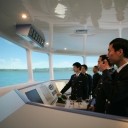Securing of the Vessel Over Night
Procedures for Ensuring Ship is Secure at Night
It is not uncommon at sea for weather conditions to change for the worse suddenly and without prior warning. If this happens overnight, and the vessel is not fully prepared, it can be at least inconvenient, and at the worst dangerous to call out crew in darkness in order to secure and put things right. It shall be our prudent policy to secure the vessel every night, in anticipation of possible problems. In case of overnight operations (such as tank-cleaning, ventilation, etc) the policy may be modified as necessary only by the Chief Officer, and with careful consideration of prevailing and forecast conditions.
In addition to Bridge Memo - "Securing of Accommodation", the following procedure shall be adopted :-
The Bosun is responsible for seeing that the vessel is secure at night or at the end of the deck crew working day. This will include the following:-
1. All W/T doors are closed, fully dogged down, and padlocked where appropriate.
2. All working accesses opened up for routine work to be secured as necessary.
3. All ventilator flaps are closed, including those on forecastle.
4. All drums and other stores are correctly secured around the ship.
5. No loose gear on the forecastle or main deck.
6. Lights switched off where applicable. Pay particular attention to any that can interfere with navigation lights, or affect the vision of lookouts.
The Bosun should report to the Bridge when this is done. The OOW shall record this report in the Deck Logbook. Do not rely on NEGATIVE reporting. ( This means, if you do not receive a report you assume everything is OK. ) You must rely on POSITIVE reporting only. If no report is received within reasonable time, the OOW must take responsibility to contact the Bosun or C/O to find out why.
check the main deck areas and forecastle, using binoculars if needed, to ensure that nothing has been forgotten. The Deck crew normally stops work at 1200 hrs. on Sunday. It is important to check that no-one has subsequently opened something up and not closed it properly in afternoon. This might occur, for example, if bunkers are being transferred. During overnight or late night working for tank cleaning it is up to OOW to ensure that the duty crew secure the ship before stopping work.
During the hours of darkness, the OOW must make frequent observations of the weather decks from bridge to ensure nothing is amiss. Floodlights or Searchlights may be used to facilitate this, PROVIDED IT DOES NOT INTERFERE WITH SAFE NAVIGATION.
It is important to listen as well as see. Both anchors always bang to some extent in heavy weather, but listen for excessive banging that might indicate the anchor lashings have worked loose. A banging noise around the accommodation might indicate loose gear, doors swinging open, or lifeboat lashings working loose. The "talk-back unit" can be useful to listen for unusual noises in area so equipped, such as sloshing water in the forecastle for example.
REMEMBER ! Do not rely on NEGATIVE reporting, i.e. if you do not receive a report you assume everything is OK. You must rely on POSITIVE reporting only. This is when you have received a proper report stating that all is well or not well as the case may be.
-------------------------------
This Bridge Memo is developed through more than 15 years by some very experienced ship's masters.It is mainly based on Capt. Inn Davis's rules from Expedo Ship Management (Canada) Ltd.I collect them only for my personally study reason; and for easy reference purpose.
Here, I, as an officer under some instruction of Capt Davis, give my full respects and thankful to Capt. Davis.
-----------------------------------------------------
2nd Officer
Ever-student from Dalian Maritime University
Be proud of DMU
请登录后发帖

 联系我们人工客服
联系我们人工客服



















 :1391995811
:1391995811

